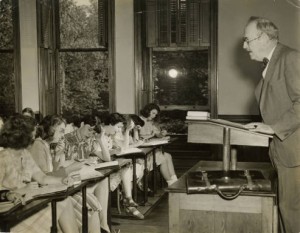
Professor Samuel Clagget Chew’s Bryn Mawr College classroom, undated, via Triptych.
This semester I’m back in the classroom, teaching a History Department seminar “Higher Education for Women: Bryn Mawr and Beyond.” With apologies to Professor Samuel Claggett Chew (pictured left), my class of smart Bryn Mawr third- and fourth-years looks absolutely nothing like the lecture class of old. We divide our time between the classroom, Special Collections, and a course blog** linking past and present.
That blog, along with links to my syllabus and digital resources, is now live:
HIST B332 Higher Education for Women: Bryn Mawr and Beyond
Although my students aren’t tweeting this semester, I’m tracking my class prep on Twitter (reviving the hashtag #bmchistory) and I look forward to using this space for reflecting on teaching the course and the research that it inspires. But today I wanted to put a call out to historians of education — how do you teach women’s higher education, in the U.S. and abroad? Similarly, how do women’s historians include the history of education in their teaching? Might we begin sharing our syllabi and readings with each other, online?
“Syllabi show how scholars put together a whole field,” reminds historian Lincoln Mullen in a recent Religion in American History blog post. “Yet unfortunately teaching documents are shared less routinely than our research, so we are much more likely to know a scholar’s books and articles than her syllabi.” This year I’m planning to overhaul the “Classroom” section of the Greenfield Center website, which currently focuses on high school lesson plans, by adding college-level syllabi and resources — much like the CLGBTH does for teaching histories of sexuality. [The Open Syllabus Project offers another intriguing model for analysis and visualization of what we teach.] In part, I’m curious to learn if and how women’s education history is being taught these days, but most of all, I continue to hope we can be more vigilant about sharing our work in the classroom, as much as we remember to share our research and digital projects.
** Students were given the option to blog anonymously, although no student has yet to choose this option. On student privacy and class blogging (or other instances of student work online that may be publicly visible), I’ve consulted this list of resources collected by Whittier College DigLibArts.
Pingback: Greenfield in the Classroom: Teaching the History of Women’s Higher Education | Monica L. Mercado, Ph.D.